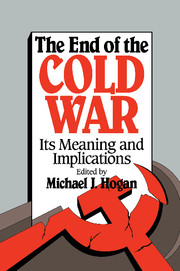Book contents
- Frontmatter
- Contents
- Preface
- The Authors
- Dedication
- 1 Introduction
- 2 An End to Which Cold War?
- 3 The Cold War, the Long Peace, and the Future
- 4 Quiet Cataclysm: Some Afterthoughts on World War III
- 5 Some Lessons from the Cold War
- 6 Nuclear Weapons and European Security during the Cold War
- 7 Victory in the Postwar Era: Despite the Cold War or Because of It?
- 8 The Wicked Witch of the West is Dead. Long Live the Wicked Witch of the East
- 9 The End and the Begining
- 10 A Balance Sheet: Lippmann, Kennan, and the Cold War
- 11 Why Did the Cold War Arise, and Why Did It End?
- 12 A View from Below
- 13 The End of the Cold War and the Middle East
- 14 The End of the Cold War in the Near East: What It Means for Historians and Policy Planners
- 15 After the Cold War: The United States, Germany, and European Security
- 16 The End of the Cold War: A Skeptical View
- 17 The End of the Cold War, the New Role for Europe, and the Decline of the United States
- 18 The Fading of the Cold War—and the Demystification of Twentieth-Century Issues
- 19 The U.S. Government, a Legacy of the Cold War
- 20 Foreign Policy, Partisan Politics, and the End of the Cold War
- 21 Beyond Bipolarity in Space and Time
- 22 A Usable Past for the Future
- Selective Bibliography
- Index
13 - The End of the Cold War and the Middle East
Published online by Cambridge University Press: 18 December 2009
- Frontmatter
- Contents
- Preface
- The Authors
- Dedication
- 1 Introduction
- 2 An End to Which Cold War?
- 3 The Cold War, the Long Peace, and the Future
- 4 Quiet Cataclysm: Some Afterthoughts on World War III
- 5 Some Lessons from the Cold War
- 6 Nuclear Weapons and European Security during the Cold War
- 7 Victory in the Postwar Era: Despite the Cold War or Because of It?
- 8 The Wicked Witch of the West is Dead. Long Live the Wicked Witch of the East
- 9 The End and the Begining
- 10 A Balance Sheet: Lippmann, Kennan, and the Cold War
- 11 Why Did the Cold War Arise, and Why Did It End?
- 12 A View from Below
- 13 The End of the Cold War and the Middle East
- 14 The End of the Cold War in the Near East: What It Means for Historians and Policy Planners
- 15 After the Cold War: The United States, Germany, and European Security
- 16 The End of the Cold War: A Skeptical View
- 17 The End of the Cold War, the New Role for Europe, and the Decline of the United States
- 18 The Fading of the Cold War—and the Demystification of Twentieth-Century Issues
- 19 The U.S. Government, a Legacy of the Cold War
- 20 Foreign Policy, Partisan Politics, and the End of the Cold War
- 21 Beyond Bipolarity in Space and Time
- 22 A Usable Past for the Future
- Selective Bibliography
- Index
Summary
The Middle East was arguably the first theater of the Cold War, which manifested itself in a number of dramatic regional developments in the four decades after 1946. In that year, Joseph Stalin's delay in removing Soviet troops on schedule from Iranian Azerbaijan and Kurdistan, where pro-Soviet autonomist regimes had been set up, brought U.S. counterpressure and a crisis that ended only with an Iranian-Soviet agreement that included the withdrawal of Soviet troops. The 1947 Truman Doctrine, arming Turkey and Greece, was the first of several U.S. military doctrines covering the Middle East and was aimed at the Soviets. Regional nationalizers of British assets in the 1950s, especially Mohammad Mosaddeq in Iran and Gamal Abdel Nasser in Egypt, were treated as dangerous and pro-Communist, and, in Mosaddeq's case, overthrown at U.S. instigation. U.S. backing for Israel was matched by Soviet backing for the Arab position and arming of favored Arab regimes, first Nasser's Egypt, and, more recently, Baathist Syria and Iraq. With the withdrawal of the British east of Suez, Saudi Arabia and especially Iran became the pillars and guardians of U.S. policy. These and other oil-rich states could afford to buy large quantities of advanced arms from the United States, while the strategic nonoil countries, Turkey, Israel, and Egypt, became three of the five largest recipients of U.S. aid, mostly military in nature. After the Soviet invasion of 1979, Afghanistan became a center for U.S.-Soviet military conflict.
Such concentration on the Middle East, which with regard to the Soviet Union was partly owing to proximity and shared borders, also grew out of American and Soviet concerns for the re-gion's oil and strategic location.
- Type
- Chapter
- Information
- The End of the Cold WarIts Meaning and Implications, pp. 151 - 160Publisher: Cambridge University PressPrint publication year: 1992
- 1
- Cited by



